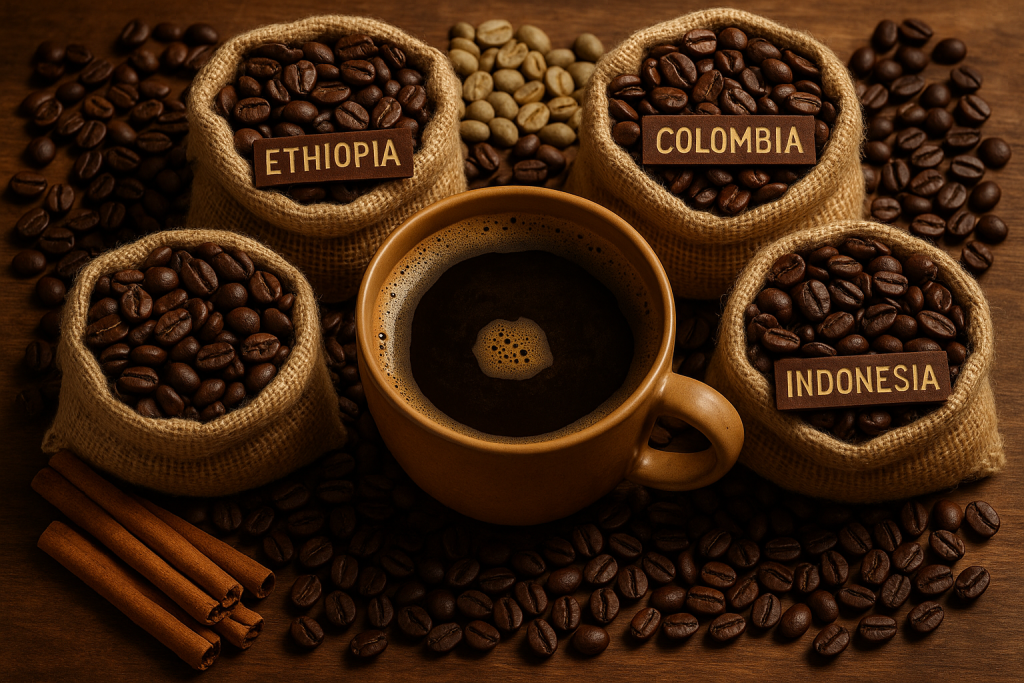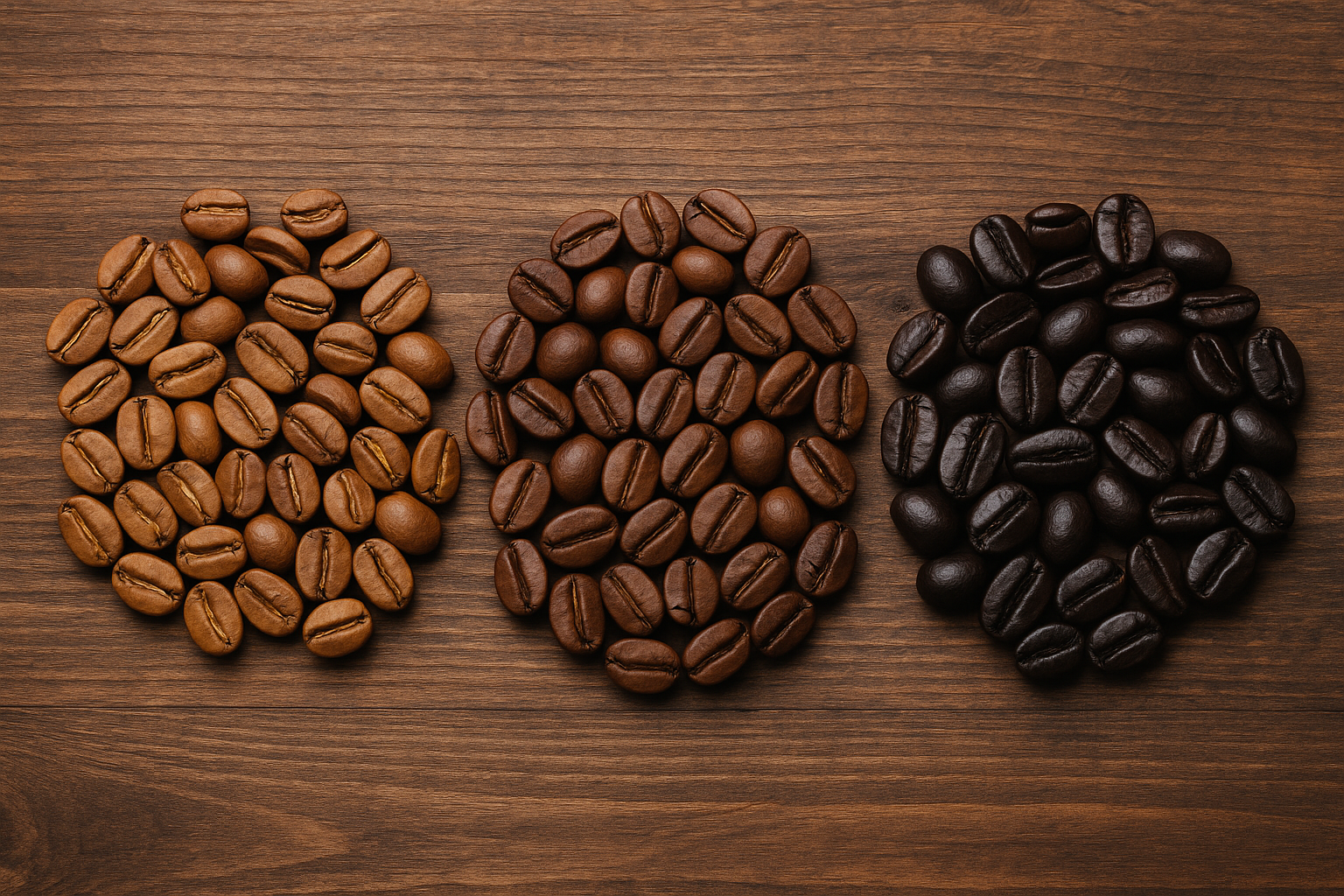Coffee is more than just a morning ritual — it’s a global journey that connects farmers, roasters, and coffee lovers across continents.
From the highlands of Ethiopia to the lush plantations of Colombia and the volcanic soils of Indonesia, the coffees of the world tell stories of tradition, geography, and culture.
Each cup offers something unique — a flavor shaped by altitude, climate, soil, and the craftsmanship of generations of growers.
In this complete guide, we’ll explore how different countries produce their distinctive coffee profiles, what makes them special, and how you can experience the world’s finest coffees right from your kitchen.

1. The Global Language of Coffee
Coffee is one of the most traded commodities on Earth — second only to oil. But beyond economics, it’s a cultural bridge.
Every region that grows coffee has its own rituals, roasting styles, and brewing traditions. Understanding the coffees of the world means appreciating how nature, culture, and science work together to create diversity in every sip.
Before we explore these origins, it helps to understand the fundamentals.
If you’re new to the world of specialty coffee, start here:
👉 Different Types of Coffee Explained
2. The Main Coffee Regions of the World
The coffee belt spans the globe between the Tropics of Cancer and Capricorn — a region known as the “Bean Belt.” Within this zone lie the three great coffee-producing regions: Africa, the Americas, and Asia-Pacific.
Each region offers its own flavor identity, influenced by altitude, soil, and processing methods.
a) Africa: The Birthplace of Coffee
Key countries: Ethiopia, Kenya, Rwanda, Tanzania
Africa is where coffee was born — and it remains home to some of the world’s most complex and aromatic beans.
- Ethiopian Coffee: Floral, fruity, and tea-like. Known for varieties like Yirgacheffe and Sidamo.
- Kenyan Coffee: Bright acidity, berry-like sweetness, and a crisp finish.
- Rwandan Coffee: Clean, sweet, with hints of citrus and honey.
African coffees are loved by specialty roasters for their vibrant and layered flavor profiles.
b) The Americas: Balance, Body, and Sweetness
Key countries: Colombia, Brazil, Costa Rica, Honduras, Guatemala
Latin America dominates global coffee exports — and it’s easy to see why. These coffees are approachable, balanced, and ideal for both espresso and filter.
- Colombian Coffee: Well-rounded, with caramel and chocolate notes.
- Brazilian Coffee: Nutty, creamy, with a low acidity and chocolate sweetness.
- Costa Rican Coffee: Bright, citrusy, and clean.
- Honduran Coffee: Smooth, sweet, and mild — often used in blends.
- Guatemalan Coffee: Full-bodied with spicy undertones.
Each Latin American cup tells a story of craftsmanship and consistency, often produced by small family farms at high altitudes.
c) Asia-Pacific: Earthy, Bold, and Mysterious
Key countries: Indonesia, Vietnam, Thailand, Papua New Guinea
The Asia-Pacific region produces coffees with a distinctive richness and earthy depth.
- Indonesian Coffee (Sumatra, Java): Heavy body, low acidity, with flavors of cocoa, spice, and herbs.
- Vietnamese Coffee: Strong, dark-roasted Robusta, traditionally served with condensed milk.
- Thai Coffee: Mild, nutty, and slightly honeyed — gaining global recognition.
- Papua New Guinea Coffee: Complex, with tropical fruit notes and a syrupy body.
These coffees often appeal to drinkers who prefer bold, full-bodied flavors.
3. What Makes Coffees Taste Different?
Even within a single country, no two coffees taste the same. That’s because flavor depends on multiple factors:
- Altitude: Higher elevations create denser beans with more acidity and complexity.
- Soil Composition: Volcanic soils enhance sweetness and body.
- Processing Method: Washed coffees are clean and bright, while natural-processed beans are fruitier and heavier.
- Varietal: Like grapes in wine, coffee plant genetics influence flavor.
- Roasting: The roaster’s technique unlocks (or hides) the bean’s full potential.
To learn how roasting brings out the best in every origin, read:
👉 How To Make A Great Coffee
4. The Role of Specialty Coffee in Showcasing World Flavors
Specialty coffee roasters play a crucial role in preserving diversity and transparency in the coffee industry.
Instead of blending beans from multiple regions, they focus on single-origin coffees, allowing each terroir to express its identity.
They highlight details like:
- Farm and altitude
- Processing method (washed, natural, honey)
- Roast level and tasting notes
This movement has helped coffee evolve from a commodity to a craft — much like fine wine or chocolate.
At Speciality Coffee Canada, the Ministry of Roasters collection features ethically sourced beans from Honduras, Thailand, and Ethiopia, roasted in small batches for maximum freshness and character.
5. Brewing the World’s Best Coffees at Home
Exploring the coffees of the world doesn’t require a passport — just a good brewing setup and some curiosity.
Top Brewing Methods:
- Pour-Over (V60, Chemex): Highlights clarity and origin character.
- French Press: Full-bodied and rich.
- Espresso Machine: Concentrated and creamy.
- Cold Brew: Smooth, low-acid, and refreshing.
Pro Tip: Always grind your coffee fresh and use filtered water between 90–96°C for the best results.
For a full brewing tutorial, check out:
👉 How To Make A Great Coffee
6. Why Caffeine Affects People Differently
Not all coffee drinkers experience caffeine the same way.
Some feel instantly energized, while others prefer decaf after lunch. The difference comes down to genetics and tolerance.
Caffeine blocks adenosine receptors in the brain, keeping you awake and alert — but your sensitivity depends on metabolism and consumption habits.
Learn more about caffeine’s fascinating effects here:
👉 Why Does Caffeine Make Us Stay Awake?
7. Sustainability: Protecting Coffees of the Future
Climate change poses a real threat to the coffees of the world.
Rising temperatures, shifting rainfall, and pests are reducing suitable growing areas.
Fortunately, many specialty roasters and cooperatives are leading the charge toward sustainability by:
- Promoting shade-grown and organic farming.
- Supporting direct trade relationships.
- Using eco-friendly roasting methods.
- Investing in reforestation and fair wages.
By choosing ethical brands like Speciality Coffee Canada, you’re helping preserve coffee’s future — one sip at a time.
8. How to Start Your World Coffee Journey
If you’re ready to taste the diversity of global coffee, here’s how to begin:
- Try a new origin each month.
Start with Ethiopia, Colombia, and Thailand to appreciate different profiles. - Buy from specialty roasters.
Look for roast dates and transparent sourcing. - Take notes.
Write down what you taste — acidity, sweetness, mouthfeel — and track your preferences. - Experiment with brewing methods.
A pour-over can reveal fruitiness, while espresso brings depth and intensity. - Share the experience.
Invite friends for a coffee tasting and compare your impressions.
Conclusion
Exploring the coffees of the world is like traveling without leaving home.
Each origin tells a different story — of soil, altitude, culture, and passion.
Whether you love the floral elegance of Ethiopian beans, the creamy sweetness of Brazilian coffee, or the nutty complexity of Thai roasts, every cup connects you to people and places across the globe.
At Speciality Coffee Canada, we celebrate that diversity by sourcing responsibly and roasting with precision — bringing the world’s best coffee flavors straight to your cup.
So, pour yourself a fresh brew, take a sip, and taste the world.
☕ FAQ — Coffees of the World
1. What are the main coffee regions of the world?
Africa, the Americas, and Asia-Pacific — each with distinct climates and flavors.
2. What is single-origin coffee?
Coffee sourced from a single farm or region, allowing you to taste its unique terroir.
3. Which country produces the best coffee?
It depends on your taste — Ethiopia for fruitiness, Colombia for balance, Indonesia for richness.
4. How can I brew international coffees at home?
Use a pour-over, French press, or espresso machine — and grind beans fresh.
5. What’s the best roast for tasting world coffees?
Medium roast — it balances acidity and sweetness, ideal for discovering origin flavors.
6. How does caffeine differ between origins?
Generally, Robusta beans (Asia) have more caffeine than Arabica (Africa & Latin America).
7. Where can I buy authentic coffees from around the world?
Shop directly at SpecialityCoffee.ca for ethically sourced, freshly roasted beans from the best global regions.

